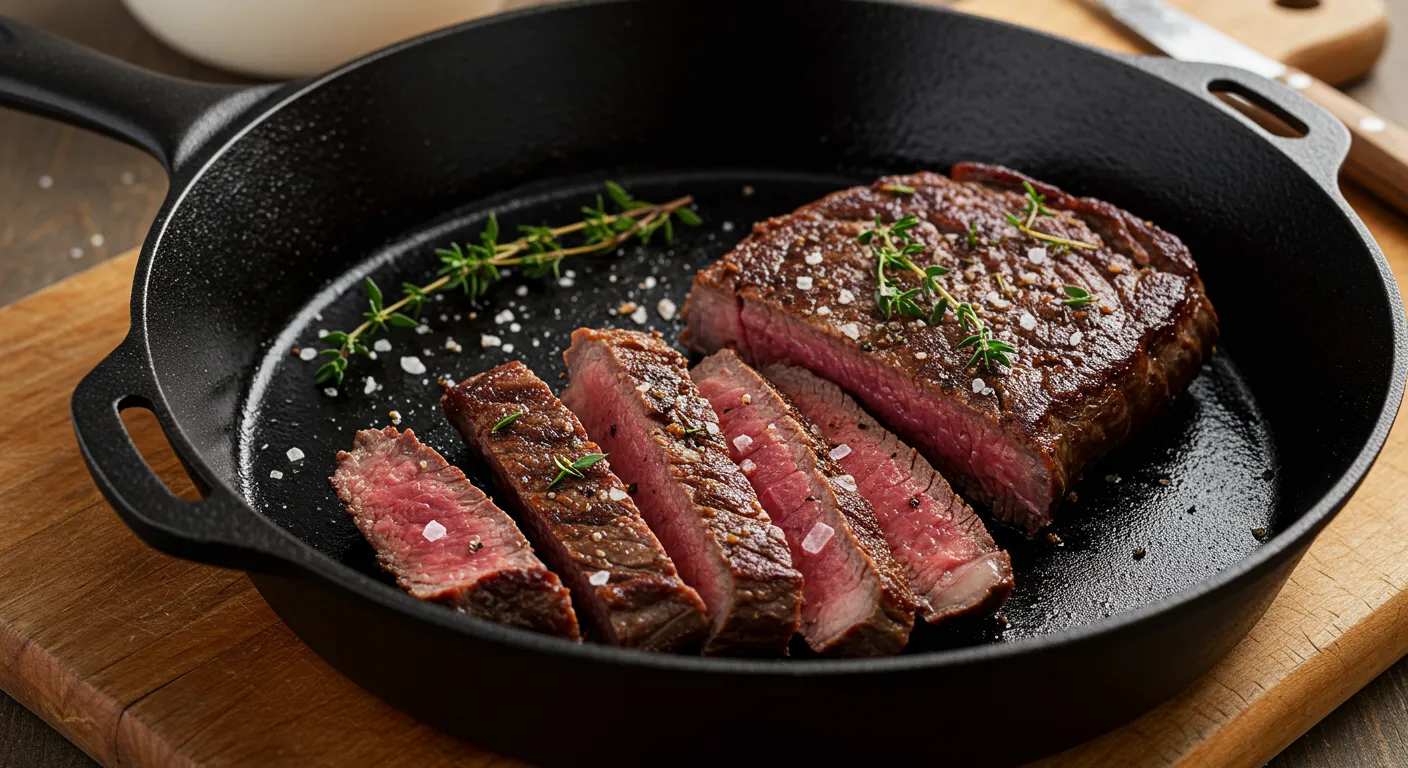There’s something truly special about a perfectly seared Delmonico steak—its rich, buttery tenderness and the mouthwatering crispy crust that forms from the high-heat searing technique. If you’ve ever savored this prime cut at a steakhouse, you know just how impressive it can be. But here’s the best part: you can achieve that same juicy, steakhouse-style perfection right in your own kitchen. In this recipe, I’ll walk you through every step of getting that perfect sear on your Delmonico steak, from the key ingredients to expert tips for flawless results every time. Ready to cook up a steak that’ll have everyone asking for seconds? Let’s dive in!
Table of Contents
Key Benefits of a Perfectly Seared Delmonico Steak
When it comes to cooking steak, there’s something truly magical about the Delmonico cut. This prime cut of beef, often regarded for its rich marbling and tender texture, brings together the best of both worlds—juicy, melt-in-your-mouth goodness with a beautifully charred exterior. Here’s why you’ll love making this recipe:
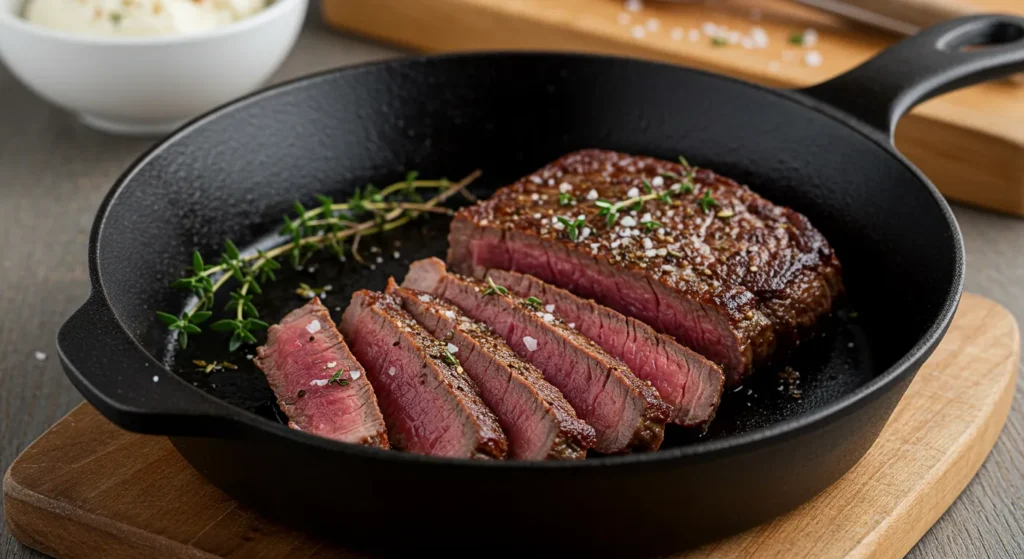
- Tender, Juicy Perfection: The Delmonico steak’s marbling ensures each bite is packed with flavor. With the right sear, it locks in moisture, keeping the steak juicy and tender.
- Steakhouse-Quality Results at Home: There’s no need for fancy equipment or a professional grill to get that steakhouse-quality finish. A cast-iron skillet and a bit of know-how are all you need for a rich, buttery texture and that satisfying crispy crust.
- Flavorful Crispy Crust: The high-heat searing technique works wonders, giving you a perfect caramelized outer layer. This creates a gorgeous contrast with the soft interior, making each bite irresistible.
- Customizable Cooking Levels: Whether you like your steak rare, medium, or well-done, the method I’ll share ensures you can easily adjust the doneness to your liking without sacrificing texture or flavor.
- Quick & Easy to Master: Don’t worry if you’re not an expert cook. This recipe breaks down the process into easy-to-follow steps, so you can master the perfect sear in no time.
With these key benefits in mind, you’re about to learn the art of cooking Delmonico steak like a pro—ensuring every steak is juicy, tender, and packed with flavor. Ready to impress your taste buds? Let’s get cooking!
Ingredients for Your Perfect Delmonico Steak
Now that you know the key benefits of this amazing steak, let’s talk ingredients. The beauty of this recipe lies in its simplicity—the fewer ingredients, the better the steak can shine. Here’s what you’ll need to create a perfect Delmonico steak with a gorgeous sear:
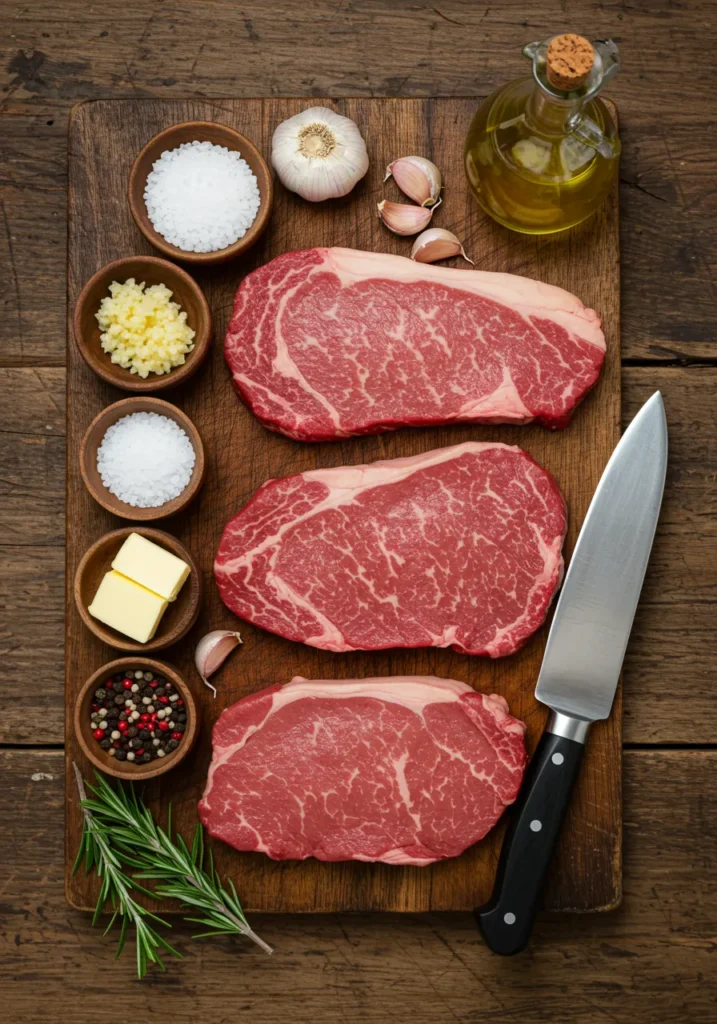
2 Delmonico Steaks (1.5–2 inches thick)
Look for high-quality cuts with plenty of marbling. The marbling adds flavor and helps keep the steak juicy during cooking.
2 tablespoons of Olive Oil or High-Heat Oil
You’ll need an oil with a high smoke point to help achieve that crispy crust without burning. Olive oil works great, but avocado or vegetable oil is also an option.
Kosher Salt
Generously season your steak with salt to help draw out its natural flavors and enhance the sear. A fine, even coating is key for that delicious crust.
Freshly Ground Black Pepper
Pepper adds a bit of heat and enhances the savory flavor. Freshly ground is always best, as pre-ground pepper can lose its punch over time.
2 tablespoons of Unsalted Butter (optional, for basting)
Adding butter at the end gives your steak a rich, indulgent finish. You can also mix in garlic or herbs to infuse more flavor while basting.
Fresh Thyme or Rosemary (optional)
Fresh herbs add a fragrant note that complements the beef beautifully. A sprig or two will elevate the steak to another level of deliciousness.
Pro Tip:
If you can, bring your Delmonico steaks to room temperature before cooking. Letting them rest for about 30 minutes outside the fridge ensures even cooking and a better sear.
With these ingredients ready, you’re all set to start cooking. It’s simple but incredibly effective—get the basics right, and the rest will fall into place!
Instructions for Cooking Your Delmonico Steak to Perfection
Now comes the fun part—cooking your Delmonico steak! Follow these simple steps to get a perfect sear every time. The key here is patience and high heat—don’t rush the process, and your steak will reward you with a delicious, crispy crust and tender interior.
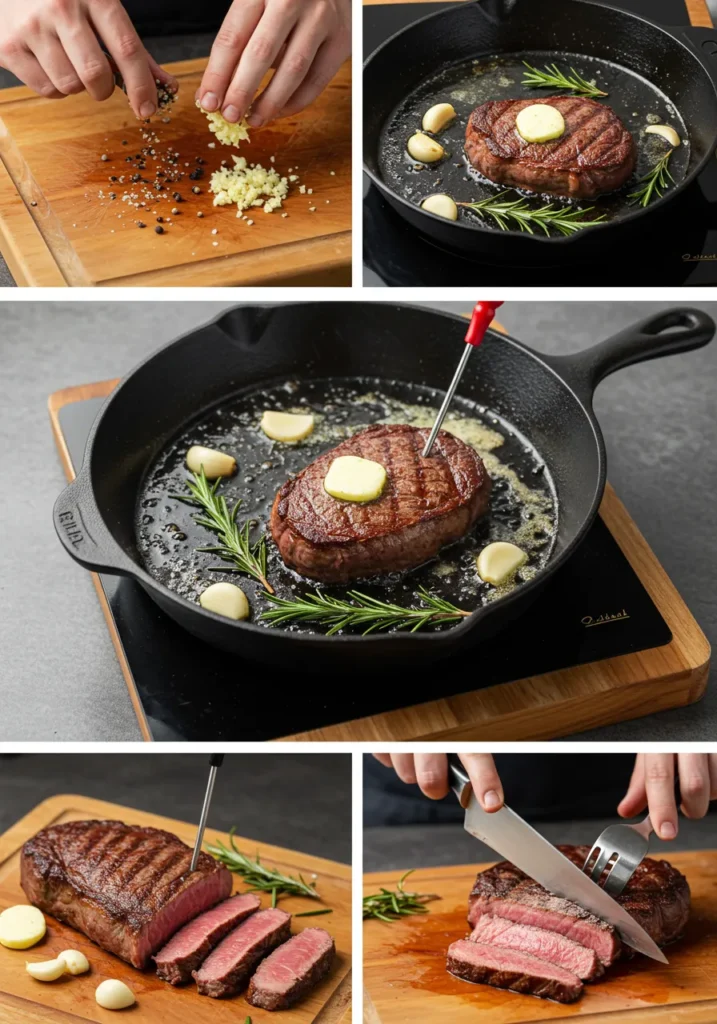
1. Preheat Your Pan
Begin by heating a cast-iron skillet over medium-high heat. Cast iron is ideal for this recipe because it retains heat well, helping you achieve that perfect sear. Let the pan get hot—really hot. This is essential for a crispy, caramelized crust.
2. Season the Steak
While the pan is heating, generously season both sides of the Delmonico steak with kosher salt and freshly ground black pepper. Make sure the seasoning is evenly distributed to enhance the steak’s natural flavor.
3. Add Oil to the Pan
Once your pan is hot, add 1–2 tablespoons of high-heat oil (like olive or avocado oil). Swirl the oil to coat the bottom of the skillet, ensuring it’s evenly distributed. You should hear a satisfying sizzle as the oil hits the pan.
4. Sear the Steak
Place the Delmonico steak in the hot pan and don’t touch it for about 4-5 minutes. The steak needs time to form a golden-brown, crispy crust. Avoid moving the steak around, as this could prevent the sear from forming. If you’re unsure, gently lift the steak with tongs to check—it should release easily from the pan.
5. Flip and Sear the Other Side
After 4-5 minutes, flip the steak over. You should see a beautifully seared crust. Sear the second side for another 4-5 minutes. For a medium-rare finish, this timing should work perfectly, but feel free to adjust for your preferred doneness.
6. Optional: Add Butter and Herbs
If you’re going for an extra luxurious touch, add 2 tablespoons of unsalted butter, along with a few sprigs of fresh thyme or rosemary, during the last minute of cooking. As the butter melts, tilt the pan slightly to spoon the butter over the steak. This basting technique infuses the steak with rich, savory flavors.
7. Check for Doneness
Use a meat thermometer to check the internal temperature. For medium-rare, aim for 130-135°F (54-57°C). Adjust your cooking time based on your preferred doneness:
Rare: 120-125°F (49-52°C)
Medium: 140-145°F (60-63°C)
Well-done: 160°F (71°C)
8. Rest the Steak
When the steak reaches your preferred doneness, take it out of the pan and let it rest on a cutting board for 5-10 minutes. This allows the juices to redistribute, ensuring each bite is as tender and juicy as possible.
And there you have it—a perfectly seared Delmonico steak! The crispy crust, juicy interior, and rich flavor are sure to impress anyone at the table. Keep these tips in mind, and you’ll make steakhouse-worthy meals right from your own kitchen.
Pro Tips and Variations
Mastering the perfect Delmonico steak goes beyond just searing—it’s about technique, seasoning, and small adjustments that elevate the final result. Here are some expert tips and variations to ensure your steak is full of rich, juicy flavor:
1. Bring the Steak to Room Temperature
For an evenly cooked steak, let it sit at room temperature for about 30-45 minutes before searing. This prevents the inside from being too cold while the outside gets a perfect crust.
2. Pat the Steak Dry for Maximum Sear
Moisture is the enemy of a crispy crust. Use a paper towel to pat the steak dry before seasoning. This helps create a golden-brown sear that locks in flavor.
3. Use the Right Cooking Oil
Choose a high smoke point oil like avocado, canola, or grapeseed oil. These oils prevent burning and allow for an even sear without overpowering the steak’s natural flavors.
4. Baste for Extra Flavor
Once the steak is nearly done, add butter, crushed garlic, and fresh herbs like rosemary or thyme to the pan. Tilt the skillet slightly and spoon the infused butter over the steak repeatedly to enhance its richness.
5. Let It Rest Before Slicing
Cutting too soon releases the juices, making the steak dry. Allow it to rest for at least 5-10 minutes on a cutting board, lightly tented with foil, to keep it warm while ensuring maximum juiciness.
Variations to Try
- Reverse Sear Method: Instead of cooking on high heat first, bake the steak at a low temperature (around 250°F) until it reaches 10-15°F below your desired doneness. Then, sear it in a hot skillet for a perfect crust.
- Smoky Flavor Twist: Add a pinch of smoked paprika or chipotle powder to your seasoning blend for a deep, smoky finish.
- Garlic Butter Crust: Mix softened butter with roasted garlic and spread it over the steak before searing to create a rich, aromatic crust.
These pro tips and variations will help you achieve steakhouse-quality results every time. Adjust the seasoning, cooking method, and finishing touches to suit your personal taste and enjoy the ultimate Delmonico steak experience!
Serving Suggestions
A perfectly cooked Delmonico steak deserves equally impressive accompaniments to elevate the dining experience. Here are some classic and creative serving ideas to complement your meal:
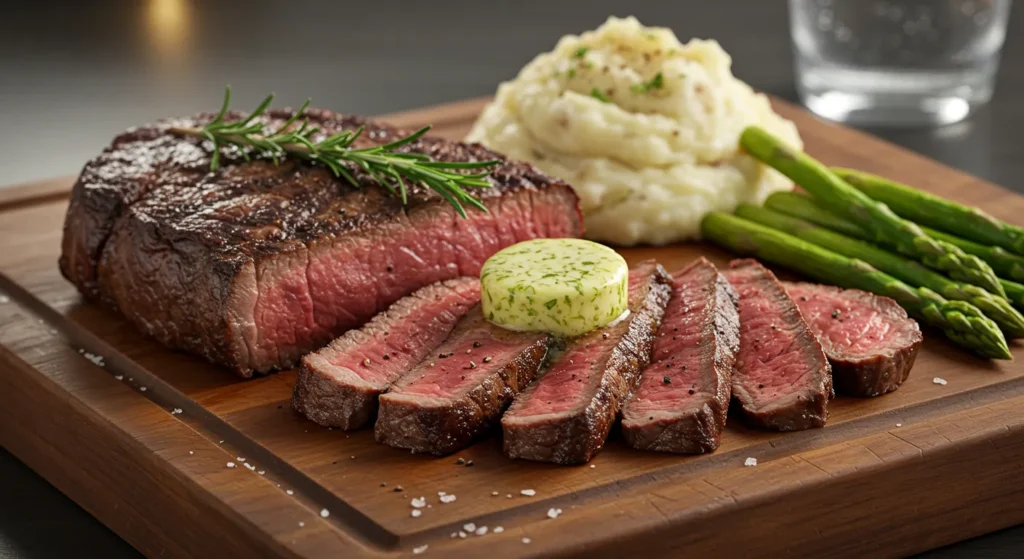
1. Classic Pairings
- Garlic Mashed Potatoes – The creamy texture and buttery flavor balance the steak’s richness.
- Grilled Asparagus – A simple yet elegant side that adds a touch of freshness.
- Creamed Spinach – A steakhouse favorite that enhances the dish with a velvety texture.
2. Gourmet Enhancements
- Red Wine Reduction Sauce – Drizzle a rich, flavorful sauce over the steak for added depth.
- Truffle Butter Topping – A decadent touch that enhances the steak’s natural juices.
- Crispy Onion Straws – Adds a delightful crunch and mild sweetness to every bite.
3. Lighter Options
- Arugula Salad with Balsamic Glaze – The peppery greens and tangy dressing contrast beautifully with the steak’s bold flavors.
- Grilled Vegetables – Bell peppers, zucchini, and mushrooms add a smoky sweetness.
4. Wine Pairing Suggestions
- A bold Cabernet Sauvignon or Malbec enhances the steak’s richness.
- If you prefer white wine, a full-bodied Chardonnay can provide a smooth, buttery contrast.
By pairing your Delmonico steak with the right sides and drinks, you create a restaurant-quality meal at home. Enjoy the perfect balance of flavors and textures with every bite!
Conclusion
Congratulations! You’ve successfully cooked a Delmonico steak to perfection, complete with a beautiful sear, tender texture, and mouthwatering flavor. Whether it’s for a special occasion or a regular dinner, this recipe guarantees a meal that will leave a lasting impression. The process might seem intricate, but with a bit of patience and attention to detail, you can create a steakhouse-quality dish right in your own kitchen.
Remember, the key to a great Delmonico steak is in the quality of the meat, the right cooking techniques, and the perfect sear. By following the steps, applying the pro tips, and choosing the right sides and sauces, you’ve crafted a truly exceptional dish that will have everyone asking for seconds.
Feel free to experiment with different variations and sides to make the recipe your own. Steak nights are all about personal preferences, so don’t hesitate to tailor the experience to suit your taste. The possibilities are endless!
Now that you’ve learned how to prepare and serve a Delmonico steak, it’s time to sit back, relax, and savor every juicy, flavorful bite. Happy cooking!
_____________
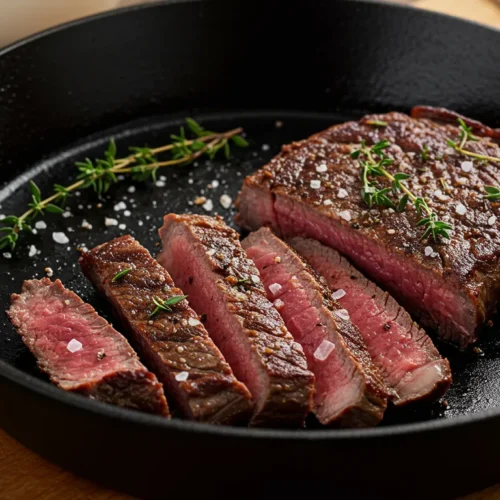
Delmonico Steak Recipe
Ingredients
2 Delmonico Steaks (1.5–2 inches thick)
- Look for high-quality cuts with plenty of marbling. The marbling adds flavor and helps keep the steak juicy during cooking.
2 tablespoons of Olive Oil or High-Heat Oil
- You’ll need an oil with a high smoke point to help achieve that crispy crust without burning. Olive oil works great but avocado or vegetable oil is also an option.
Kosher Salt
- Generously season your steak with salt to help draw out its natural flavors and enhance the sear. A fine even coating is key for that delicious crust.
Freshly Ground Black Pepper
- Pepper adds a bit of heat and enhances the savory flavor. Freshly ground is always best as pre-ground pepper can lose its punch over time.
2 tablespoons of Unsalted Butter (optional, for basting)
- Adding butter at the end gives your steak a rich indulgent finish. You can also mix in garlic or herbs to infuse more flavor while basting.
Fresh Thyme or Rosemary (optional)
- Fresh herbs add a fragrant note that complements the beef beautifully. A sprig or two will elevate the steak to another level of deliciousness.
Pro Tip:
- If you can bring your Delmonico steaks to room temperature before cooking. Letting them rest for about 30 minutes outside the fridge ensures even cooking and a better sear.
Instructions
Preheat Your Pan
- Begin by heating a cast-iron skillet over medium-high heat. Cast iron is ideal for this recipe because it retains heat well, helping you achieve that perfect sear. Let the pan get hot—really hot. This is essential for a crispy, caramelized crust.
Season the Steak
- While the pan is heating, generously season both sides of the Delmonico steak with kosher salt and freshly ground black pepper. Make sure the seasoning is evenly distributed to enhance the steak’s natural flavor.
Add Oil to the Pan
- Once your pan is hot, add 1–2 tablespoons of high-heat oil (like olive or avocado oil). Swirl the oil to coat the bottom of the skillet, ensuring it’s evenly distributed. You should hear a satisfying sizzle as the oil hits the pan.
Sear the Steak
- Place the Delmonico steak in the hot pan and don’t touch it for about 4-5 minutes. The steak needs time to form a golden-brown, crispy crust. Avoid moving the steak around, as this could prevent the sear from forming. If you’re unsure, gently lift the steak with tongs to check—it should release easily from the pan.
Flip and Sear the Other Side
- After 4-5 minutes, flip the steak over. You should see a beautifully seared crust. Sear the second side for another 4-5 minutes. For a medium-rare finish, this timing should work perfectly, but feel free to adjust for your preferred doneness.
Optional: Add Butter and Herbs
- If you’re going for an extra luxurious touch, add 2 tablespoons of unsalted butter, along with a few sprigs of fresh thyme or rosemary, during the last minute of cooking. As the butter melts, tilt the pan slightly to spoon the butter over the steak. This basting technique infuses the steak with rich, savory flavors.
Check for Doneness
- Use a meat thermometer to check the internal temperature. For medium-rare, aim for 130-135°F (54-57°C). Adjust your cooking time based on your preferred doneness:
- Rare: 120-125°F (49-52°C)
- Medium: 140-145°F (60-63°C)
- Well-done: 160°F (71°C)
Rest the Steak
- When the steak reaches your preferred doneness, take it out of the pan and let it rest on a cutting board for 5-10 minutes. This allows the juices to redistribute, ensuring each bite is as tender and juicy as possible.
Notes
- Calories: 550
- Total Fat: 45g
- Saturated Fat: 18g
- Cholesterol: 115mg
- Sodium: 180mg
- Carbohydrates: 0g
- Fiber: 0g
- Sugars: 0g
- Protein: 45g
- Iron: 15% of Daily Value
FAQs
Cooking a Delmonico steak can seem like an art, and you might have some lingering questions before you get started. Don’t worry—I’m here to guide you! Here are some of the most frequently asked questions to help ensure your steak turns out perfectly every time.
1. How do I know when my Delmonico steak is cooked to the right level?
The best way to check the doneness of your Delmonico steak is with a meat thermometer. Here are the internal temperatures to aim for:
Rare: 120-125°F (49-52°C)
Medium-rare: 130-135°F (54-57°C)
Medium: 140-145°F (60-63°C)
Medium-well: 150-155°F (66-68°C)
Well-done: 160°F (71°C) and above
Once your steak reaches the desired temperature, let it rest for 5-10 minutes before cutting to allow the juices to redistribute.
2. Can I cook Delmonico steak on a grill instead of a skillet?
Absolutely! Delmonico steak is perfect for grilling, and you can follow the same cooking times as you would on the stovetop. Preheat the grill to medium-high heat and cook the steak, flipping only once, to develop that nice sear on both sides. The smoky flavor from the grill adds another layer of deliciousness.
3. What can I do if my steak turns out too tough?
If your steak feels tough, it might be because it wasn’t cooked long enough, or the meat was of lower quality. The key to tenderness lies in both the cut of meat and how you cook it. Make sure to allow the steak to rest after cooking, and consider tenderizing it with a marinade that contains an acidic component like vinegar or citrus before cooking.
4. Can I use a different steak cut for this recipe?
While Delmonico steak is known for its tenderness and rich flavor, you can swap it out for other cuts like ribeye or New York strip if necessary. However, keep in mind that each cut has its own texture and flavor, so cooking times might vary slightly depending on the thickness and marbling.
5. What are the best sides to serve with Delmonico steak?
Some great side options include mashed potatoes, grilled vegetables like asparagus or Brussels sprouts, sautéed mushrooms, or a fresh salad. A rich sauce like garlic herb butter or peppercorn sauce also pairs wonderfully with the steak, adding even more depth to the meal.
6. Can I prepare Delmonico steak in advance?
While it’s best to cook Delmonico steak fresh for optimal flavor and texture, you can prep it ahead of time by seasoning it and letting it rest in the fridge for up to 4 hours before cooking. This helps the seasoning penetrate the meat and ensures a flavorful result. However, avoid cooking it fully in advance, as reheating can lead to a less tender steak.
By answering these frequently asked questions, I hope I’ve cleared up any uncertainties you might have. Cooking Delmonico steak is all about technique, patience, and personal preference—so feel free to experiment and find what works best for you.

